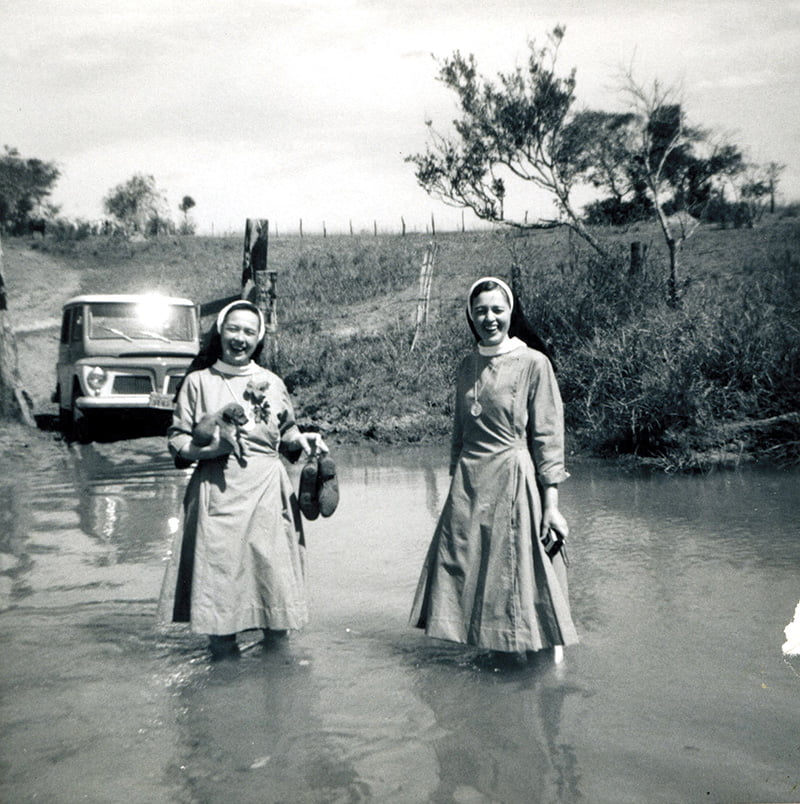
by Ellie Melero and Olivia Martin
Special to The Leaven
Sister Irene Skeehan, SCL, returned from her three years in Peru in 1966.
More than 50 years later, she still misses it.
Sister Irene was one of the first people the Sisters of Charity of Leavenworth sent to Talara, Peru, in 1963. She helped found the Sisters’ mission there. And during her time there, she grew to love the people and culture of Peru.
So much so, that she didn’t want to come back.
“When I came home, I was the last of the first group to get back to the States,” Sister Irene said, her voice cracking and her eyes tearing up. “I thought, when I came home, that I was going back [to Peru].
“And then I didn’t go back. That was heartbreaking for me.”
You see, Sister Irene had fallen in love with the people she went to help. And she was not alone.
A call to action
In his 1959 encyclical “Princeps pastorum” (“Prince of the shepherds”), Pope John XXIII asked Catholics worldwide to rededicate themselves to mission, and many religious orders in the United States responded by founding missions in Latin America.
The men and women who answered the call went to different places for different reasons.
But it didn’t take many of them long to understand why they had been called to mission work.
“It was a wonderful, very satisfying experience,” said Sister Elaine Gregory, OSB. “It was an extremely large amount of work, but it was an extremely satisfying thing.”
Sister Elaine arrived at the Benedictine mission in Mineiros, Brazil, in 1967, seven years after the monks founded the mission and three years after the first Sisters joined them. Like many missionaries, Sister Elaine volunteered for the mission because she felt she had something to offer and thought she could make a difference.
And she did make a difference.
During her 15 years in Brazil, Sister Elaine helped teach sacramental preparation classes, led Bible studies, taught English at the public school, started a night school program to improve literacy among adults and helped start 22 rural schools for children who lived too far from the city to attend school.
Sister Elaine enjoyed her work and was proud of it.
But that’s not what she loved or misses about Mineiros. It was the people.
“It’s been a marvelous life experience,” Sister Elaine said. “I’m grateful for everything, and I’m grateful for all the people I knew and loved down there, the friends I had.”
That was a sentiment shared by Father Duane Roy, OSB, and Sister Grace Malaney, OSB, as well — two fellow Benedictine missionaries to Brazil.
Father Duane returned from 47 years in Brazil in 2018. And if it was up to him, he would still be there. As a priest, he was constantly surrounded by people at Mass and meetings, and he developed many close relationships with the people.
“Missionary work is basically friendship,” said Father Duane. “90 percent friendship and 10 percent technique.”
“I tried to live along that line,” he continued. “I’ve always seen myself as a nice guy, easygoing. The Brazilian people kind of pulled more of that out of me.”
That was a lesson all the missionaries learned early on: Missionary work is building friendships.
When they first arrived in Brazil, all the missionaries had to go to language school for a couple of months before they could start their work. For Sister Grace, the language barrier turned out to be a blessing in disguise.
“It was good in that the people themselves became my teachers,” said Sister Grace. “They’re a very welcoming, hospitable people, and so it was more like they were receiving me than I was doing anything for them.
“Being on the receiving end of these folks that I thought I was going down there to minister to, that completely turns your perception around.”
Sister Grace and the others built friendships with the Brazilians early on, and they soon learned the people had as much to offer them as they had to offer the people.
This realization rid them of any preconceptions they had, which allowed them to have more fruitful missionary experiences.
“We didn’t know what they needed,” said Sister Elaine. “Americans don’t know what they need. But talk with them and listen to them and you found out what it was that they really needed from us.”
Ugly Americans . . . at first
A few thousand kilometers away, the Sisters of Charity learned a similar lesson in Peru.
At 32, Sister Irene was the second youngest sister to go to Talara to found the mission, and she volunteered to go because to her it sounded like an adventure. She wasn’t sure what to expect from Peru, but she was still surprised at the people’s lack of punctuality and more traditional attitudes when she got there.
Sometimes, she would get annoyed when meetings would get put on hold because someone came late and had to greet everyone in the room individually. But she slowly started to appreciate the Peruvian culture more and more.
That’s when she realized the American way isn’t always the best way.
“We were typical ugly Americans,” Sister Irene said. “We always had the intention of helping the poor, so we had that service charism that we always have. But we also had the baggage that ‘the best way to do this charism is the way we do things.’
“When you really begin to look at yourself, you say, ‘These people may not know how to stand in line, but they are the most loving people.’ And you just have to get used to things.”
Sister Irene said it was easier to work with the people once she embraced their culture . . . and she was not the only one who thought so.
Sister Regina Deitchman, SCL, ended up serving in Peru for 44 years in many different towns and cities, including Talara, Chilaco and Negritos. Cities in different regions of the country had their own traditions and cultural variations, and Sister Regina found the best way to get along with the people was to respect those differences.
“I learned to try to listen to what people have to say,” Sister Regina said, “and not think I have the answer to every problem. And I learned to respect other people’s culture, other people’s way of being.”
Much like the Benedictine missionaries in Brazil, the Sisters of Charity worked closely with the people and found they could learn a lot from the Peruvians.
Sister Josephine Bustos, SCL, said the resourcefulness she learned from the Peruvians is something she’s never forgotten, and it helped her a lot in her assignments when she returned to the States.
“You have to be resourceful to be able to do different things,” Sister Josephine said. “You learn from them, and then you’ll teach them new things, too.”
The visiting religious didn’t only learn from the native people the advantages of their simpler lifestyles.
They also learned a lot about their faith. The missionaries found the natives to be faithful and devout people, and many found their own spiritual lives grew the more time they spent with the people.
Sister Grace reflected on the lessons she learned during her first Christmas in Brazil.
“Christmas is not a real big feast,” Sister Grace said. “They weren’t big into exchanging gifts, but every family had a little crib. There were no lights, no tinsel, no tree.
“But their cultural expression of their faith was not dominated by gift-giving and all the hoopla we have surrounding Christmas up here.
“You get it down there. There was nothing to take you away from what happened on that day.”
No one left unchanged
Although they went at different times and to different places, the missionaries interviewed all shared one thing in common: When their time came to return to the United States, nobody really wanted to go.
Many didn’t want to leave the friends they had made during their time in South America.
Some just didn’t think they belonged in the States anymore.
“From the poverty I was living in [there] and then to come to everything here, it was just shocking,” Sister Regina said. “Now here I am living in it — in splendor.”
Their experiences, the missionaries felt, had changed them for the better — and there was no going back to the people they were before.
But, return they did. And in retrospect, they share one prevailing emotion: gratitude.
To a person, they are glad they answered God’s call to go.
“It was a real life-changer for me,” Sister Irene said. “I had done service opportunities as a high school kid in Tulsa where I’m from, but never, ever had experienced the poverty that I saw [in Peru].
“I think it made me a more compassionate person.
“And I still miss it.”


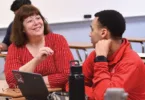
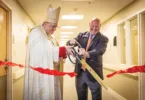
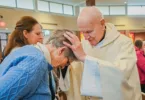
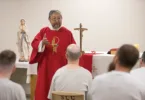

I wish you would list the Sisters of Charity by their respective names when they took their vows for those of us old to remember those names, and have no idea what their respective given names were. In fact, it would have been considered impolite back them to ask a nun what her “real” name was! It was so refreshing to see the Charity nuns on the front page in the current issue of the Leaven in their old habits that my wife and I remember so well. It’s too bad that we can’t identify them by the names you listed. God Bless those nuns who were such a huge influence in our lives growing up. It’s too bad Vatican II destroyed that for today’s youngsters. It is sorely needed in our current environment, and in our Catholic School System.